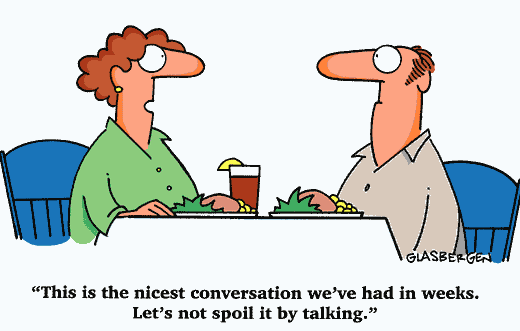
This may be a personal preference, but whenever I’m browsing through novels at an author event, I’ll usually open to a few random pages and look for some dialogue. Generally, if I can’t find any dialogue at all, I’ll put the book back down, since I’m not really interested in stories without any social interactions. If I do find some conversations, I’ll take a moment to look for warning signs of bad writing. Info-dumps, stilted dialogue, line after line of inane small-talk… if I find any of these in abundance, I can be pretty sure that the story would not be one that I would enjoy.
Dialogue between characters is one of the most engaging forms of storytelling we have. It’s highly effective at breaking down complex conflicts and ideas into digestible bites and can give life to an otherwise bland cast of characters. But many writers struggle when giving voice to the people in their stories. Here are a few tips and things to remember when putting words into your characters’ mouths.
Don’t get hung up on dialogue tags.
I’ve known many writers who obsess over finding synonyms for the word “said”. They seem convinced that the reader will toss their book away in derision if “said” is said once too often (joke intended). Perhaps it’s because I got my start by writing for the theater, but I’ve never really gotten hung up over dialogue tags. In a script, each line is designated by a character name and a colon. This quickly conveys the only essential information we need, namely, who is speaking. If you’re really concerned about overusing a specific dialogue tag, try using descriptions of body language to identify who is speaking instead.
People are going to sound similar.
Much like dialogue tags, some writers fixate on trying to make all of their characters sound like distinct, different people. While this is a commendable goal, at some point an author needs to accept that many of her characters will sound similar, and that’s ok. Trying to make everyone feel totally different is like trying to write a plot that no-one has ever heard before. It’s amazing if you can do it, but it isn’t necessary to telling a great story. Better to focus on a few key characters and give them distinct voices to set them apart from what the average person in your story sounds like.
Every line doesn’t have to serve the main plot.
While you should definitely consider cutting or changing an entire scene that doesn’t contribute to the storyline, not every statement made by a character has to be directly tied to the resolution of the primary conflict. Sometimes the reader needs a break, and a few lines of dialogue can be the ‘flavor text’ of a story. Not essential, but colorful and entertaining. Funny interludes, character studies, and brief heart-to-hearts all have their place within the overarching narrative.
Avoid writing business meetings.
While dialogue is a great way to consolidate plot information and facilitate action, anyone who has been in a long business meeting knows that sometimes lots of talking can result in nothing but numb rear ends. The same is true for fictional business meetings. Any time you have a large group of characters sitting around talking about their situation for too many pages (I’ve even seen meetings that lasted multiple chapters!) without doing anything, you run the risk of losing your reader. Keep focused, and keep the number of conversationalists to a manageable level.
What tips have helped you when writing dialogue? Share them in the comments below!
If you liked this article, you can subscribe to my monthly newsletter for links to more articles, writing tips, sneak peeks, and other special offers.
A big shout-out to the wonderful members of my Writers Community:
Christine Herbert, Michele Cacano, Jessica Mormann, Naltath, and Jo Sal.
If you’d like to learn more about my Writers Community, check out the following link: